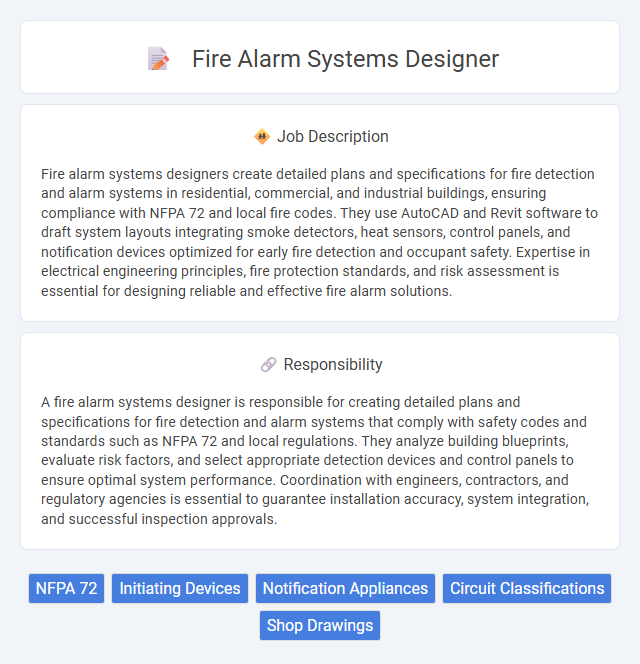
Fire alarm systems designers create detailed plans and specifications for fire detection and alarm systems in residential, commercial, and industrial buildings, ensuring compliance with NFPA 72 and local fire codes. They use AutoCAD and Revit software to draft system layouts integrating smoke detectors, heat sensors, control panels, and notification devices optimized for early fire detection and occupant safety. Expertise in electrical engineering principles, fire protection standards, and risk assessment is essential for designing reliable and effective fire alarm solutions.
Individuals who thrive in fire alarm system design likely possess strong analytical skills and attention to detail, essential for creating reliable safety solutions. Those comfortable with technical problem-solving and working under regulatory standards may find this role well-suited to their abilities. People who prefer dynamic environments and collaborative projects probably experience greater job satisfaction in this field.
Qualification
A Fire Alarm Systems Designer must possess strong knowledge of fire safety codes, NFPA standards, and electrical engineering principles. Certification such as NICET Level II or higher in Fire Alarm Systems is often required, along with experience in CAD software for designing fire alarm layouts. Proficiency in conducting risk assessments and coordinating with fire protection engineers ensures compliance and system reliability.
Responsibility
A fire alarm systems designer is responsible for creating detailed plans and specifications for fire detection and alarm systems that comply with safety codes and standards such as NFPA 72 and local regulations. They analyze building blueprints, evaluate risk factors, and select appropriate detection devices and control panels to ensure optimal system performance. Coordination with engineers, contractors, and regulatory agencies is essential to guarantee installation accuracy, system integration, and successful inspection approvals.
Benefit
Fire alarm systems designers likely increase building safety by creating efficient detection and alert mechanisms, potentially reducing the risk of fire-related damage and loss. Their specialized knowledge may enhance compliance with safety regulations, which could prevent costly fines or legal issues for clients. The role probably offers a strong job market demand as fire safety remains a priority in both new constructions and renovations.
Challenge
Designing fire alarm systems likely presents complex challenges involving the integration of advanced technologies with building codes and safety regulations to ensure optimal protection. The role probably demands meticulous attention to detail and problem-solving skills to address diverse architectural layouts and potential fire scenarios. Balancing innovation with compliance could be a consistent test of expertise for professionals in this field.
Career Advancement
A fire alarm systems designer plays a critical role in developing and optimizing life safety infrastructure by creating detailed plans and specifications for fire detection and alarm systems. Career advancement in this field often involves gaining certifications such as NICET or becoming a licensed fire protection engineer, which can lead to senior design roles, project management, and consultancy positions. Expertise in emerging technologies like smart fire detection and integration with building management systems enhances job prospects and opens pathways to leadership in safety engineering firms.
Key Terms
NFPA 72
Fire alarm systems designers specialize in creating life safety solutions compliant with NFPA 72, the National Fire Alarm and Signaling Code. They develop detailed plans that integrate fire detection devices, notification appliances, and control units to ensure effective emergency response. Expertise in NFPA 72 requirements guarantees system reliability, code compliance, and occupant safety in diverse building environments.
Initiating Devices
Fire alarm systems designers specialize in specifying initiating devices such as smoke detectors, heat detectors, and manual pull stations to ensure timely fire detection and occupant safety. They analyze building codes and environmental factors to select devices that optimize sensitivity and reduce false alarms. Expertise in integrating these initiating components with control panels enhances system reliability and code compliance.
Notification Appliances
A Fire Alarm Systems Designer specializes in creating layouts for notification appliances such as horns, strobes, and speakers to ensure optimal audibility and visibility during emergencies. The role demands familiarity with NFPA 72 standards and local fire codes to strategically position devices for maximum coverage and compliance. Expertise in integrating synchronization, power requirements, and device compatibility enhances system effectiveness and occupant safety.
Circuit Classifications
Fire alarm systems designers specialize in creating circuits that comply with NFPA 72 standards, ensuring proper classification of initiating and notification appliance circuits. They categorize circuits into Class A, B, C, D, and X to optimize system reliability, fault tolerance, and monitoring capabilities. Expertise in circuit classifications directly impacts system performance, enabling rapid detection and response during fire emergencies.
Shop Drawings
Fire alarm systems designers specialize in creating detailed shop drawings that outline the layout, wiring, and component placement for fire detection and alarm systems. These drawings ensure compliance with local fire codes, NFPA standards, and integration with building architecture for precise installation and inspection. Accurate shop drawings facilitate coordination among engineers, contractors, and inspectors, minimizing errors and project delays in fire alarm system deployment.
 kuljobs.com
kuljobs.com